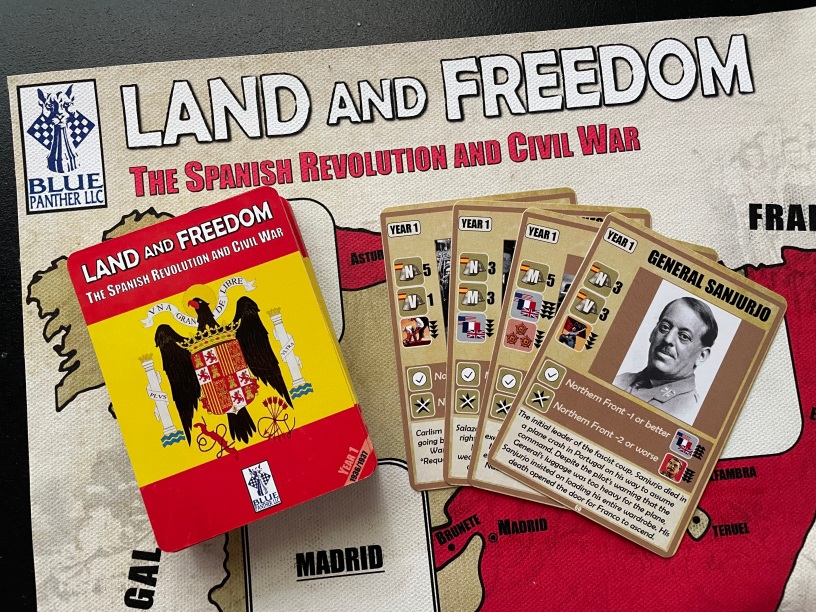Land and Freedom: The Spanish Revolution and Civil War is a very interesting and unique card-driven in which players are play the roles of various factions who are attempting to work together to repel the Fascist attack on Spain’s sovereignty. The three sides, including the Moderates, Anarchists and Communists, have to work together in a loose alliance against the Fascists but also in an attempt to keep each ideology in check and win the game by amassing the most glory. The game looks at Spain in the framework of 4 separate geographic Fronts, which players have to defend using only their whits and the cards at their disposal. These cards can be used for their powerful events or placed into a tableau where in later turns the play of matching symbol cards here can trigger a very powerful and game changing momentum swing. The game is semi-cooperative, and what is meant by that is that all of the players will lose the game if 2 of the Fronts or Madrid are lost but if they sufficiently work together to keep the Fascist invasion at bay, they can then win individually for their ideology by amassing the most Glory through their brave deeds, skillful manipulation of the turn order and focus on increasing their hold on important aspects such as government control, external support from world powers in the form of Foreign Aid, the increase of individual liberty or a focus on collectivization.
In Action Point 1, we took a look at the Game Board and discussed the Fronts and various Tracks that belong to the different factions. In this Action Point, we will examine the anatomy of the Player Cards in the game and discuss the use of their Action Points and Events as well as the Fascist Event Cards.
Player Cards
Land and Freedom relies on cards as the main focus of the game and each of the players has their own unique deck that focuses on not only the Fronts and cooperatively battling the Fascists but gives each player cards specifically tailored to how they are trying to win. The Player Decks contain 18 total cards and in a regular game the player will draw and have access to all of the cards in their deck but will only be able to play a total of 16 of those cards at a clip of 4 cards per round. The makeup of these cards in the Player Decks consists of 12 cards with strength 1, 5 cards with strength 2 and one card with strength 3, which is referred to as the Leader Card. This strength is similar to Operations Points in other games and can be used to fuel actions by the player.

As you can see from the breakdown above, most of your cards (66.7%) have just 1 Action Point and you will have to plan for the most effective use of these cards in order to stand of chance of fighting off the advancing Fascists while also attempting to win the war for control for your faction. While you have a good number of 2 Action Point cards, you only have the 1 Leader Card, which is very powerful, and should be used when it can bring the greatest benefit to the table either for its powerful Event text or for the use of its 3 AP.
At the start of each Year in the game, players will draw 5 cards to their hand from their Player Deck. Each Year consists of 4 Fascist Event Cards being drawn and then each player being allowed to play 1 card per Fascist Event which means that each Year the players will only play 4 different cards from their hand. This means that the players will have many options in their hands as they will have extra cards and these extra cards build up over the game. For example, at the start of Year 1, players will have 5 cards in their hand and will play just 4. Then at the start of Year 2, they will draw 5 additional cards and will retain the 1 un-played card from their hand for a total hand size of 6 cards. During, Year 3 they will carry over 2 cards and have 5 new cards drawn for a total pool of 7 cards. I really liked the fact that I was able to see all of the cards in my deck, even if I wasn’t able to play all of those cards. It just meant that I had choices about what cards to play each turn. This was a really nice design for this game.
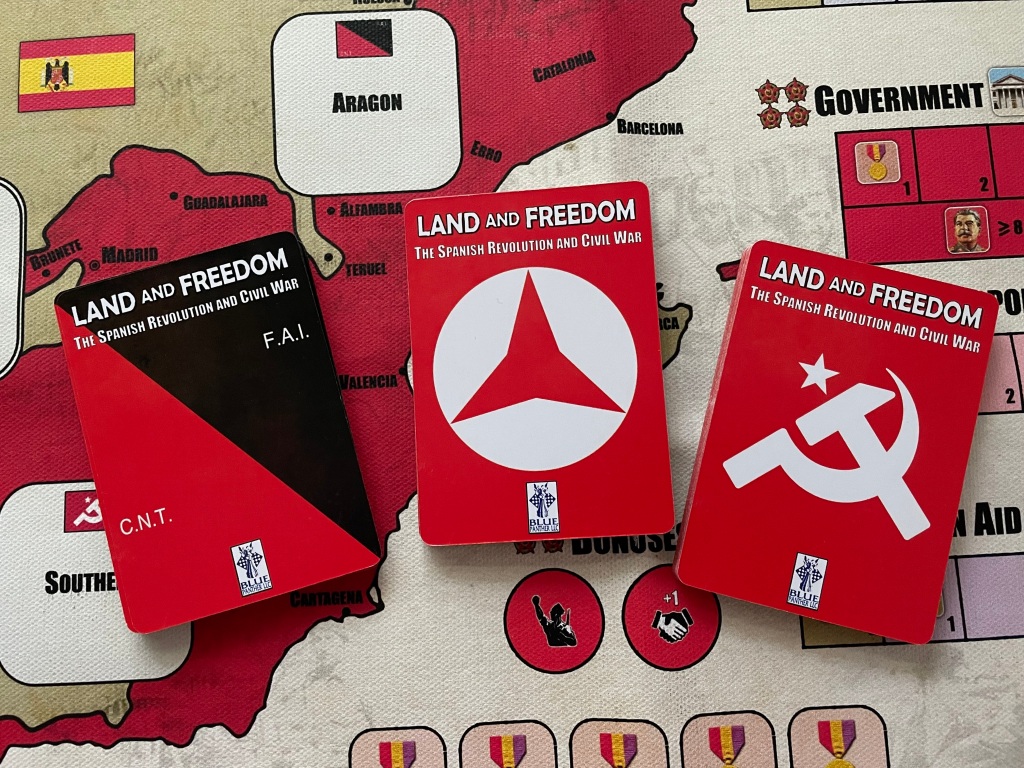
Let’s now take a look at the anatomy of these cards and then discuss their uses.
At the top of each Player Card is a title that refers to a historical event or person associated with the Spanish Revolution or Civil War. These are vastly different for each of the three factions as their associated leaders, participants and events are referred to. To the left of the card title is the card’s Action Points. There are either 1, 2 or 3 Action Points listed here and these AP can be used to take various actions on one area of the board including attacking Fronts, effecting one of the various Tracks on the board or turning on 1 of the 2 Bonuses. Once played for the AP, these cards are then placed into the players Tableau to be used later. Located to the left of the picture on the card are the various icons associated with the various Tracks on the board. These are activated by using the AP on the card to take an action and then augment or increase the strength of that action by using matching symbols on the cards your Tableau to increase their effectiveness.
Below the picture on the card is the Event. The Event text is usually very powerful and players have to execute all of the text there in that block and cannot pick and choose what they want and don’t want to play. Once a card is played for the Event, it is removed from the game and placed back into the box. This means that card will not be seen again. Remember that players will draw all of the cards in their deck but there are Events or other abilities that allow for drawing extra cards so you can cycle through your deck. If cards are played for the Event, they will not be available in this case.
Finally, located at the bottom of the card is the historical text that describes and expands upon the event or person highlighted in the title. I love flavor text like this in my Card Driven Games as I love to learn about the history of the time period I am playing in.
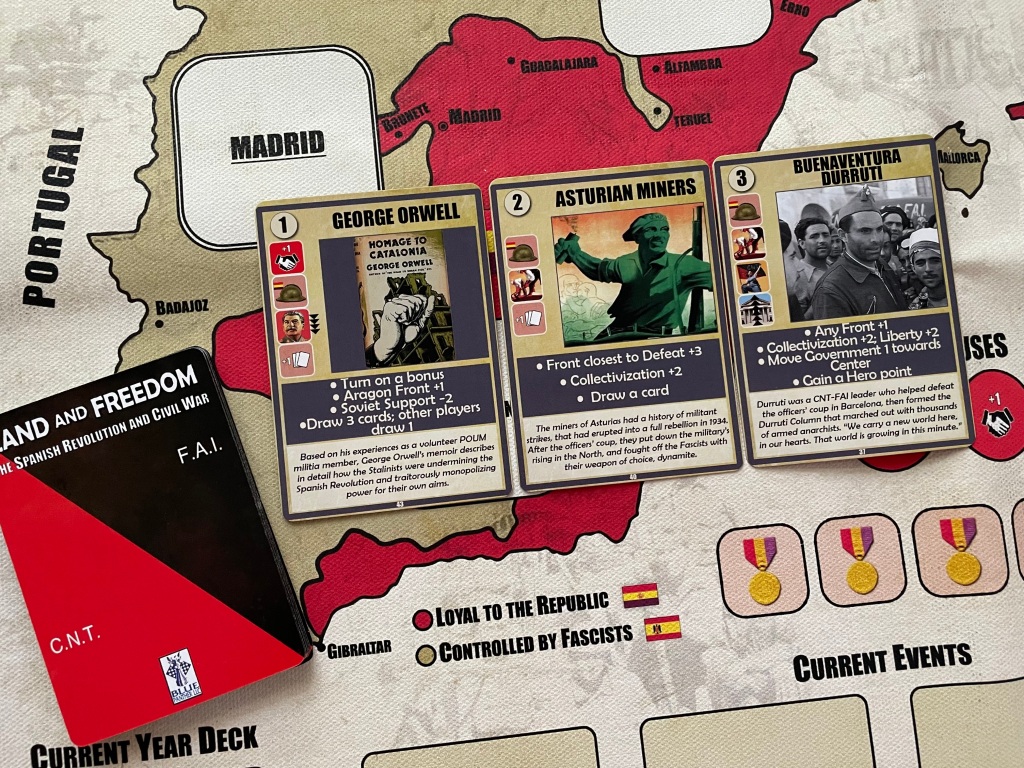
So now that you understand the anatomy of the Player Cards, let’s take a look at how they are used. Each turn, which is defined as a Fascist Card being drawn and its text enacted, then all players will play one card from their hand. Cards can be played in two ways – either for the card’s Event effects or for the Action Points along with the possible Morale Bonus from matching symbols. Each player will decide what card they are playing and play it facedown. When all players have done so, in turn each player will play their card for the Action Points or Event.
Probably the most overlooked and missed parts of the game is the cards and how they work. When a card is played for its Action Point, these points can be used to affect just one area of the board. This can be chosen by the player and can include a single Front, any 1 of the 5 Tracks, or to turn on Bonuses, including the Team Work or Morale Bonus. If the cards are used to effect a Front, the player will get to add strength to a single Front equal to the AP value of the card played. If the card is a 2 AP card and it is played on the Aragon Front, it can either add 2 Republican Strength Markers or remove 2 Fascist Strength Markers. It cannot be used to add/remove 1 Strength Marker to the Aragon Front and then add/remove another 1 Strength Marker from the Madrid Front.
The Action Points can also be used to move a single Track on the board that number of steps and this choice can be made to move the chosen Track either up or down by the AP value of the card played. The same restriction applies to the Tracks as to the fronts and a player cannot move one Track up 1 while moving another Track down 1 with a 2 AP card. Then if the movement of the Track would cause the Track Marker to land on or cross over a Trigger, the player can then enact the effects of the trigger which could allow another Track to be modified.
Finally, Action Points can be used to turn on the Morale Bonus, the Teamwork Bonus or both by spending 1 AP per Bonus that is to be effected. This is different from the restriction on Fronts and Tracks. Did you catch that? You have to keep this straight in your head or your hard earned victory will be null and void as you will have played the game incorrectly, which is what happened to us on our first play until we realized the mistake and corrected it in Year 2. But, no harm no foul as we lost that game even with playing it incorrectly.
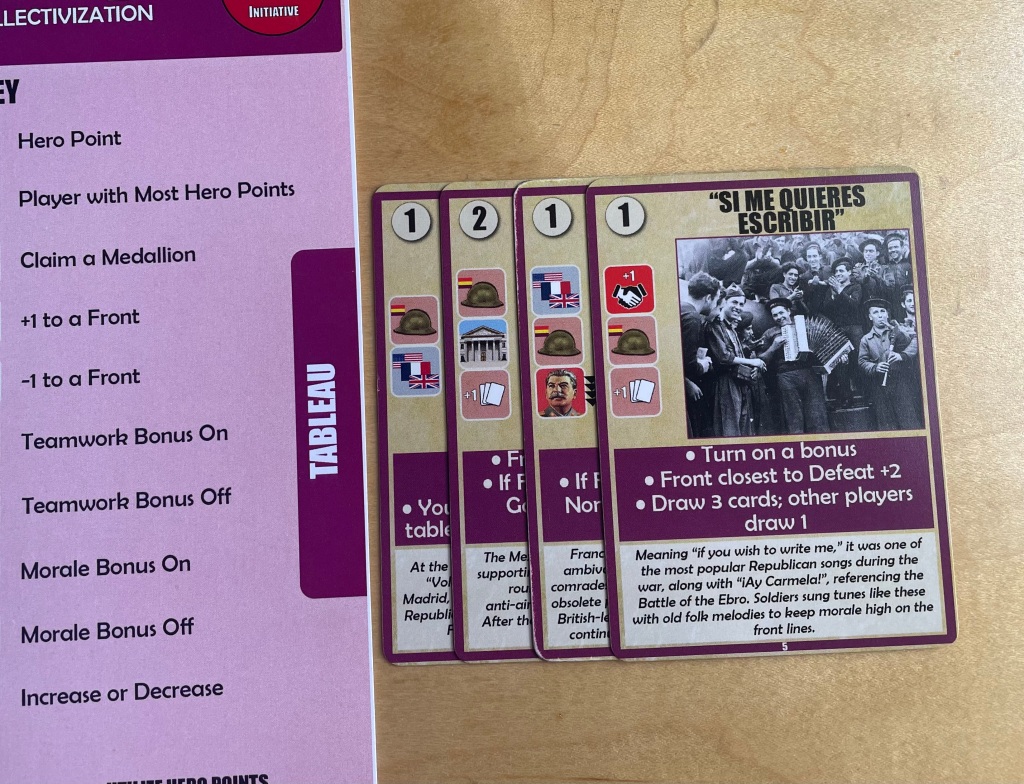
You just have to remember that Action Points cannot be divided into multiple areas of the board. If any AP is left over at the end of the turn, these are simply wasted and have no effect.
Now that you see what Player Cards are like, let’s take a look at the Fascist Event Cards.
Fascist Event Cards
The first part of each Turn involves revealing 1 new Fascist Event Card from the Current Year Deck. These cards are the match to the gasoline of the conflict and will create problems for the players by adding Fascist Strength Markers to various Fronts and reducing various Tracks but also providing an opportunity for reward if the players have successfully worked together to defeat the Test identified on the card. There are 3 full years in the game, which consists of drawing 4 Fascist Event Cards each Year and then each player playing one of the cards from their hand in order. There are specific Fascist Event Cards for Year 1, Year 2 and Year 3 and the difficulty of these cards definitely ramps up from Year 1 to Year 3, both in the form of Fascist Attacks on the Fronts as well as with various other negative effects.
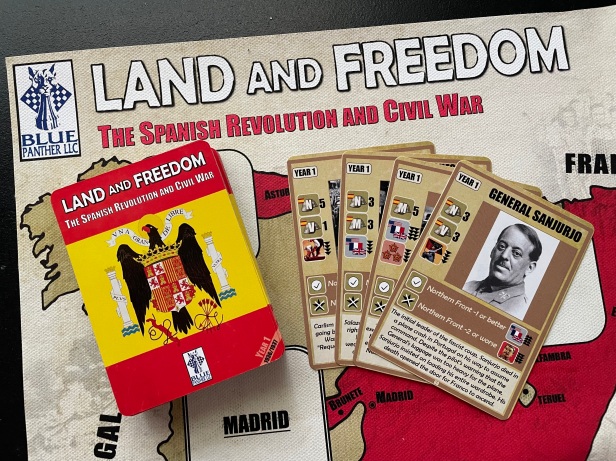
Let’s take a look at the anatomy of these Fascist Event Cards. At the top of each Fascist Event Card is the card’s title, which refers to some historical event that effected either the Spanish Revolution or Civil War. To the left of the title is the Year of the card, either Year 1, Year 2 or Year 3. The backs of these cards all look similar with the exception of the Year text in the bottom right hand corner.
Under the card’s title is a historical picture and to the left of the picture is found the negative effects of the card by the use of symbols. Mostly, this area will include the Front Attack Marker symbol and will direct the placement of a certain number of Attack Markers on one or more of the Fronts. These are identified by a letter; “A” for Aragon, “M” for Madrid, “N” for Northern and “S” for Southern. There also is sometimes a reference to “V” or “D”, which refers to the Front that is closest to Victory or Defeat. Then to the right of the Attack Marker symbol will be a number of Attack Markers to be placed on each of the identified Fronts ranging from 1-9. These numbers will increase as the Years go by and the attacks are progressively worse in Years 2 and 3.

Finally, each Fascist Event Card also contains what is referred to as a Test. This Test is found in the brown colored box area directly below the picture. These Tests will provided challenges to the players to support a specific Front to increase its value to a certain threshold. As an example, the Year 1 “Volunteers” from Fascist Italy card shown above has a Test that requires the players to have the Madrid Front at 0 or greater and will provide them with the ability to increase the Government Track by 1 space (shown by the courthouse style building façade) but also if the Aragon Front is at -1 or worse then the Foreign Aid Track (shown by the 3 national flags of the United States, France and Great Britain) will decrease twice. These Tests are resolved after the players play their chosen card for the turn. The great thing about these Tests is that sometimes you may not care about the Test result and you don’t have to worry about spending your turn doing anything to meet the requirements of the Test. But, sometimes they will matter desperately to you but maybe not so much to your opponents. This is where cooperation and selfishness come into contact and jeopardize the delicate balance between the 3 powers and the players. I love this tension in the game and find that players that don’t work together will find other players being less concerned about winning the game and will just focus on their own goals.
At the bottom of the cards is found historical flavor text to give you an idea about the event or person portrayed. These touches are always nice as I want to not only play the game, and have a good time doing it, but also learn something about the conflict portrayed and expand my understanding of the reasons behind it.
I hope that you have enjoyed this quick look at the Player Cards and Fascist Event Cards used in Land and Freedom. These cards are the main focus of the game and understanding how they are used, and how the players are forced to effectively cooperate with their play, is key to victory. If player’s don’t cooperate well, they will find the Fronts collapsing and the game will be lost. Players have to strike a good balance between working as a team while also focusing on effecting their own Tracks to reach Triggers and bonuses needed to win.
If you are interested, we posted an interview with the designer Alex Knight and you can read that at the following link: https://theplayersaid.com/2023/02/06/interview-with-alex-knight-designer-of-land-and-freedom-the-spanish-revolution-and-civil-war-from-blue-panther-llc/
Also, the game can be ordered for $65.00 from the Blue Panther LLC website at the following link: https://www.bluepantherllc.com/products/land-and-freedom
In Action Point 3, we will take a look at the Morale and Teamwork Bonuses and how they are best used by the players.
-Grant
